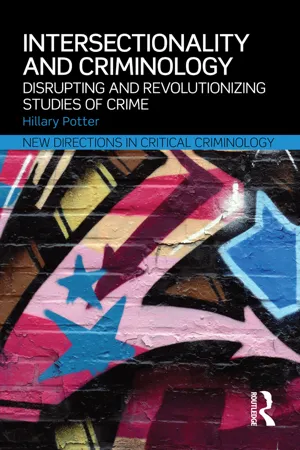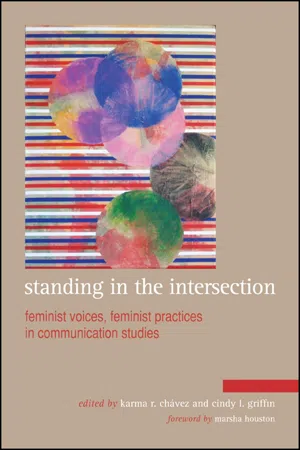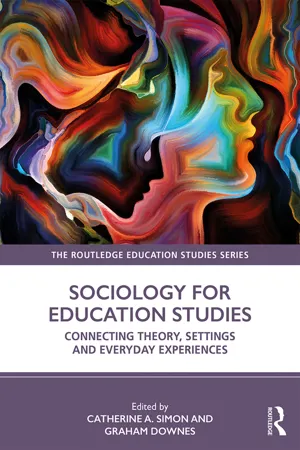Kimberle Crenshaw
Kimberlé Crenshaw is a prominent scholar and professor of law known for her work in critical race theory and intersectionality. She is best known for coining the term "intersectionality," which highlights the interconnected nature of social categorizations such as race, gender, and class, and how they overlap and intersect to create unique experiences of discrimination and privilege.
6 Key excerpts on "Kimberle Crenshaw"
- eBook - ePub
Intersectionality and Criminology
Disrupting and revolutionizing studies of crime
- Hillary Potter(Author)
- 2015(Publication Date)
- Routledge(Publisher)
...Crenshaw (1991) focused on the intersecting mechanisms of race and gender and did not explicitly address how sexuality, nationality, and class, among other identities and statuses, further compound one’s experiences; yet she did stress that the concept of intersectionality can and should take these other identities and statuses into account. For Crenshaw, the most pressing issue is not that the classifications exist; rather, in her conceptualization of the identity and power categorizations in intersectionality, the importance lies in the social principles affixed to the categories and the resultant hierarchies that are created. There has been immense application of intersectionality as a concept by many scholars, throughout many academic disciplines, and across many identities, but intellectual dissonance has ensued. Discourse has focused on (1) the use or exploitation of intersectionality to understand experiences beyond certain groups (that is, its use with those who are not Black women), (2) the co-opting or misappropriation of intersectionality by certain scholars, (3) the precise definition of intersectionality, and (4) the capacity or strength of intersectionality as a theoretical or methodological tool (I address this final point in the next section of this chapter). Feminist theorist Sirma Bilge (2013:410) observed that divergences regarding intersectionality – similar to the fate of other traveling perspectives that transcend disciplines and societies – have resulted in intersectionality’s “widespread misrepresentation, tokenization, displacement, and disarticulation” and reflect “power struggles, opportunity structures, and turf wars” within academic disciplines. Legal scholar Jennifer C...
- eBook - ePub
- Miriam E. David, Marilyn J. Amey(Authors)
- 2020(Publication Date)
- SAGE Publications Ltd(Publisher)
...She called for the law to demarginalize the status of women of color. Rather than ignoring such women in publications about race or gender, it was necessary to center them in the analysis, whether the area be in education, affirmative action, employment, housing, personal injury, or traditional female subjects, such as sexual harassment, reproductive rights, welfare reform, and domestic violence. Intersectionality Crenshaw’s Demarginalizing article introduced the notion of intersectionality into legal discourse, and the concept is now broadly applied in a number of disciplines. To fully understand the situation of women of color requires not only looking at their racial identity and their gender identity but also exploring the intersection of these identities. For example, a Black woman is not simply Black or simply a woman, but a holistic Black woman. Mari Matsuda developed the notion of multiple consciousness to describe how women of color may view the world based upon their several identities. Identity While the initial CRF scholarship emphasized the intersection of race/ethnicity and gender, publications began to complicate the analysis of the intersections by bringing in other identities. Some identities may permit you to experience privileging, while others may subject you to discrimination, simultaneously. For instance, being a professor may give you a privileged status at a university, but being a Black person may subject you to police harassment on that very same campus. Among the additional identities that can come into play are nationality, color, class, sexual orientation, religion, age, disability, language, minority, marital, and parenthood status. Praxis Like CRT, CRF can involve praxis. For example, Crenshaw cofounded and is the executive director of a nongovernmental organization, the African American Policy Forum...
- eBook - ePub
Feminist Theory Reader
Local and Global Perspectives
- Carole McCann, Seung-kyung Kim, Emek Ergun, Carole R. McCann, Seung-kyung Kim, Emek Ergun(Authors)
- 2020(Publication Date)
- Routledge(Publisher)
...As initially articulated by Kimberlé Crenshaw, intersectionality offered a “methodology that ultimately disrupt[ed] the tendencies to see race and gender as exclusive or separable” (Crenshaw 1993a). Recent intersectional analyses build on Crenshaw’s formulation by paying attention to the “relationships and interactions between multiple axes of identity and multiple dimensions of social organization—at the same time” (Reading 14). Bonnie Thornton Dill and Ruth Enid Zambrana provide a comprehensive review of intersectionality as a feminist “analytic strategy” in Reading 14. They trace intersectional thinking back to early women’s and ethnic studies and locate its roots in social justice movements. They note that “inequality and oppression are deeply woven into the tapestry of American life.” And yet, because social scientific theories of inequality have ignored the ways in which “dimension[s] of inequality” are co-constituted, they cannot adequately account for the experiences of women of color. The intersectional approach identifies subjects that “occupy multiple social locations,” attends to the complexity of their experiences, and all the while remains committed to social justice. This commitment is articulated through building knowledge that “incorporates the many contradictory and overlapping ways that human life is experienced,” while paying attention to how power operates in and through social structures, interpersonal relationships, discourse, and representation (Reading 14). Ultimately, the authors argue that intersectionality offers three interventions: (1) It grounds theory in the lived experiences of the marginalized to identify counterhegemonic narratives, enabling theorists to attend to both oppression and privilege. (2) It pushes theory beyond essentialized identity categories by allowing for nuanced accounts of complexity and variation within and across difference...
- eBook - ePub
Standing in the Intersection
Feminist Voices, Feminist Practices in Communication Studies
- Karma R. Chavez, Cindy L. Griffin, Karma R. Chavez, Cindy L. Griffin(Authors)
- 2012(Publication Date)
- SUNY Press(Publisher)
...Crenshaw's early work articulated the ways in which the experiences of women of color, poor, and immigrant women are subsumed and erased in legal practices, political decisions, and social norms. This erasure occurs, according to Crenshaw, because in fundamental ways, all women are assumed to be white, and all Blacks are assumed to be men within arenas such as law, politics, and media representation. 11 Crenshaw explains how an inability to think outside of singular axes of identity has detrimental effects for women of color. Through examining how both feminist and antiracist identity discourse elide the problem of difference, and how race and gender (as well as class and sexuality) interact in the lives of women of color, Crenshaw evidences the need to prioritize the multiple factors that constitute the lives of women of color, as opposed to attending only to issues of gender or race. For example, focusing only on a single axis of identity, such as gender, when constructing policies and offering services designed to help rape survivors ignores the many resources that may not be available to women of color due to race, class, and culture. Because all women can become victims of rape, it might seem as if any policy or service provision designed to help women as a general category should be sufficient; however, race, gender, and class interact to construe different experiences for women of color and poor women as compared to white and middle-class women. White, middle-class women, for instance, are more likely to be financially secure than working-class women of color...
- eBook - ePub
Sociology for Education Studies
Connecting Theory, Settings and Everyday Experiences
- Catherine A. Simon, Graham Downes, Stephen Ward, Catherine A. Simon, Graham Downes(Authors)
- 2020(Publication Date)
- Routledge(Publisher)
...H. and Bilge, S. (2016) Intersectionality. Cambridge: Polity Press. Crenshaw, K. (1990) Mapping the margins: Intersectionality, identity politics, and violence against women of color. Stanford Law Review, 43 (6), pp. 1241–1299. Lykke, N. (2010) Feminist Studies: A Guide to Intersectional Theory, Methodology and Writing. Abingdon: Routledge. Showunmi, V. (2017) The role of the “Black Girls' Club”: Challenging the status quo. In Martin, J. L., Nickels, A. E. and Sharp-Grier, M. (Eds.). Feminist Pedagogy, Practice, and Activism: Improving Lives for Girls and Women. New York: Routledge. References Baldwin, J. (1955) Notes on a Native Son. Boston: Beacon Books. Bernal, D. D. (2002). Critical race theory, Latino critical theory, and critical raced-gendered epistemologies: Recognizing students of color as holders and creators of knowledge. Qualitative Inquiry, 8 (1), pp. 105–126. Calmore, J. (1995) Racialized space and the culture of segregation: ‘Hewing a stone of hope from a mountain of despair’. University of Pennsylvania Law Review, 143 (5), pp. 1233–1273. Castro-Salazar, R. and Bagley, C. (2010) ‘Ni de aqui ni from there’. Navigating between contexts: Counter-narratives of undocumented Mexican students in the United States. Race Ethnicity and Education, 13 (1) pp. 23–40. Collins, P. H. (1998). Fighting Words: Black Women and the Search for Justice. Minneapolis: University of Minnesota Press. Crenshaw, K. (1990). Mapping the margins: Intersectionality, identity politics, and violence against women of color. Stanford Law Review, 43, pp. 1241–1299. Delgado Bernal, D. (2002). Critical race theory, Latino critical theory, and critical raced-gendered epistemologies: Recognizing students of color as holders and creators of knowledge. Qualitative Inquiry, 8 (1), pp. 105–126. Delgado, R. (Ed.) (1995). Critical Race Theory: The Cutting Edge. Philadelphia: Temple University Press. Delgado, R. and Stefancic, J. (2001). Critical Race Theory: An Introduction...
- eBook - ePub
Human Trafficking
Applying Research, Theory, and Case Studies
- Noel B. Busch-Armendariz, Maura B. Nsonwu, Laurie C. Heffron(Authors)
- 2017(Publication Date)
- SAGE Publications, Inc(Publisher)
...Kim, 2015, Thousand Oaks, CA: SAGE Publications. Copyright 2015 by SAGE Publications. Reprinted with permission. Critical Race Theory (CRT) is part of the broader umbrella of critical approaches that allow us to examine the ways in which socially constructed notions of race, class, and gender, for example, influence the ways in which trafficked persons are oppressed and experience oppression. In the case of foreign-born survivors of human trafficking, we may also entertain the added element of nativity, nationality, and/or citizenship status. Critical race theory has its origins in critical postmodern theory and is based on the assumptions that race is a social construction; race permeates all aspects of social life; and race-based ideology is threaded throughout society (Ortiz & Jani, 2010). Critical race theory focuses on social justice, liberation, and a transformative response to not only racial oppression but also to gender and class oppression. Another useful aspect of a critical approach is the concept of intersectionality that recognizes that race, gender, religion, ethnicity, sexual orientation, and class coexist to shape social identity, behavior, opportunities, and access to rights. Introduced by Kimberle Crenshaw (1991), intersectionality refers to the ways in which multiple forms of oppression are interrelated. Social constructions of age, gender, and race, for example, do not act independently of one another in how they inform identity, discrimination, and social inequality. The concept of intersectionality offers a way to understand complex identities and the impact of social structures on the lived experience (Mattsson, 2014)...





